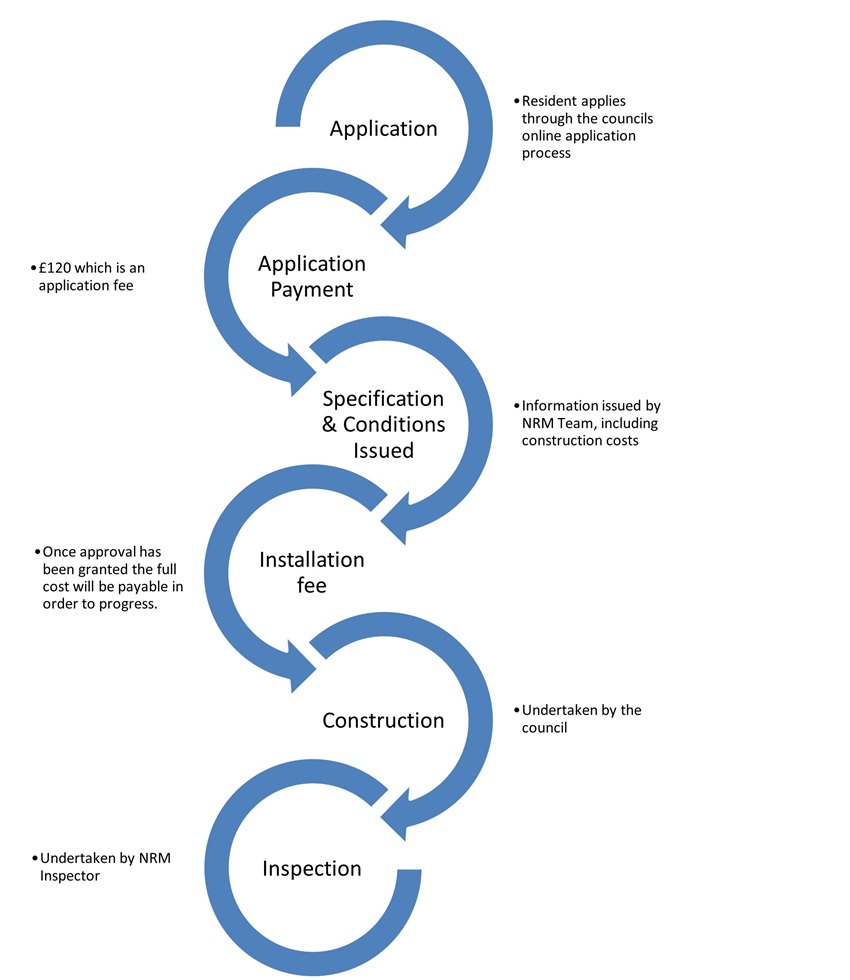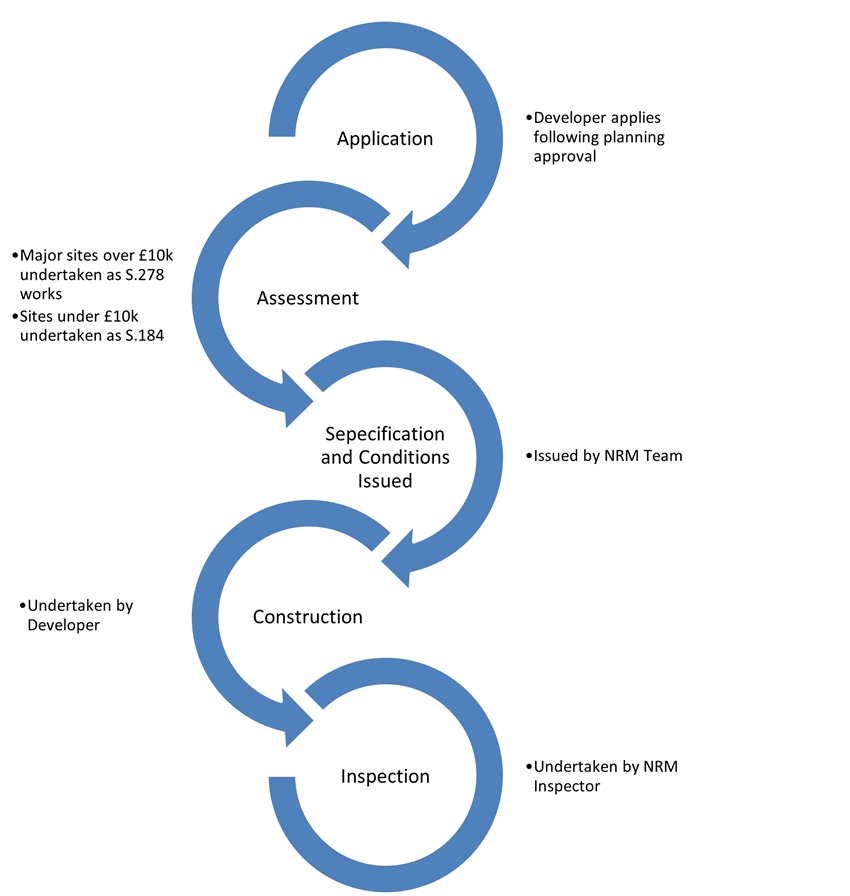
Vehicle crossings policy
Contents
- 1 Background
- 2 Council position
- 3 Legislation and guidance
- 4 Guidance for officers
- 5 Unauthorised vehicle crossings - enforcement procedure
- 6 Financial aspects and costs to the Authority
- 7 Enforcement timescales
- 8 Notes
- Appendix 1 – Ancillary issues
- Policy review
1 Background
This policy sets out the legal background and procedures involved in dealing with vehicle crossings across footways and verges and their construction.
2 Council position
Taking a vehicle across a footway and/or verge area without a correctly constructed vehicle crossing may cause damage to the structure of the footway/verge, and may also cause damage to statutory undertaker’s apparatus beneath the footway/verge area.
It is an offence to move a vehicle from the road to private land across a verge or footway without the use of a properly constructed vehicular crossing.
Furthermore, it is an offence to carry out works on the public highway without the permission of the Highway Authority, and any works undertaken should be planned, executed and properly coordinated under the auspices of the New Roads and Street Works Act 1991, and the Traffic Management (City of Bradford Metropolitan District Council) Permit Scheme Order 2015.
It is an offence to work in the Highway without possession of appropriate public liability insurance, and relevant street works qualifications.
3 Legislation and guidance
- S.184 (Highways Act 1980) – vehicle crossings over footways and verges
- S.54 (New Roads and Streetworks Act 1991) – Advance notice of certain works
- Traffic Management (City of Bradford Metropolitan District Council) Permit Scheme Order 2015
- The Street Works (Qualifications of Operatives and Supervisors) (England) Regulations 2016
4 Guidance for officers
Definition of Highway
“Highway” in this instance is defined as either:
Footway, verge and carriageway maintained at public expense;
The surface layers of any area considered to be a public right of way (including un-adopted streets) but not any areas of private land or private road that do not form a right of way.
A public right of way is determined as any roadway or footpath that is not maintained at public expense, is not designated as Private and – under common law - is defined as follows:
“A highway is a way over which all members of the public have the right to pass and re-pass. Their use of the way must be as of right, not on sufferance or by licence".
A private road is considered to be one signed as such or one that is closed to public by means of barrier or gate (or possibly simply by the presence of a barrier or gate). The onus on proof of a highway being classed as private lies with the landowner making the claim.
The definitive record of Highway Maintained at Public expense is held by The City of Bradford MDC Highway Records Officer, Anisah Naz, 01274 433707 or [email protected].
Definition of mechanically propelled vehicle
Any vehicle that moves under motorised power via internal combustion engine, hybrid or electric motor except for mobility scooters and electric cycles.
Definition of vehicular crossing
A specific crossing point constructed to a set specified engineering standard capable of bearing the weight of the semi-regular passage of mechanically propelled vehicles as defined above, as defined and specified by the Highway Authority.
This does not include pedestrian crossing points at kerb radii or otherwise, zebra, pelican or toucan crossings. There are two types of vehicular crossing, each with differing levels of construction
- Residential – to and from one property only
- Major and Non Domestic – to and from multiple properties, parking areas and commercial premises
Procurement and construction of vehicular crossings
Bradford Council are to construct all vehicle crossings internally.
Process for residential vehicle crossing applications

Process for major or non-domestic vehicle crossings

5 Unauthorised vehicle crossings - enforcement procedure
An unauthorised vehicle crossing can be defined in two ways:
- An area of footway/verge used to take a vehicle from the carriageway into a privately owned residence
- A crossing that has not been constructed to the correct specification.
The Highway Authority has powers to construct a vehicle crossing into a property and recharge the cost back to the landowner/occupier where no crossing has been constructed, and to modify/bring up to standard any area of illegally constructed crossing. In all cases the procedure for enforcement is the same:
- The case is to be logged on the proprietary highways case management system.
- Photographic Evidence of the crossing area is to be taken, noting any damage to the verge/footway as necessary.
- A letter should be sent to the resident/business explaining the Authority’s position on the matter and requesting action within 28 days to either
- Apply for and construct a correct vehicle crossing or;
- Return the area to its original condition and cease using it.
- At the end of 28 days, if no action has been taken then a second letter should be sent informing the resident/business of the Authority’s intent to carry out enforcement and construct a crossing point at cost, plus expenses, to be recharged to the relevant party.
- The resident/business will be informed of a date for enforcement construction (as agreed with the Highway Delivery Unit, but no sooner than 14 days from the date of the second letter)
- Persistent issues/prolonged delays/obstructions to enforcement are to be dealt with via the use of the Community Protection Notice procedure shown below.
Use of Community Protection Warnings / Notices (CPW / CPN)
CPW/CPN’s are intended to be served in cases of persistent antisocial behaviour. In order for a CPW/CPN to be issued a definitive pattern of repeat offences needs to be established.
Should a property owner delay the construction of a vehicle crossing by means of obstruction or obfuscation, then the issue of a CPW/CPN will be considered.
The issuing of a CPW/CPN is a formal process that requires evidence of it having a detrimental effect in the local community.
The issuing of a CPW/CPN may only be authorised by the Principal Engineer, Traffic and Enforcement Coordination and Traffic Officers, Network Resilience and Management.
Issues of disability, and low income will be considered as mitigating circumstances in enforcement cases of this nature, on provision of suitable evidence.
6 Financial aspects and costs to the Authority
Officer time spent dealing with enforcement of vehicle crossing issues is to be recorded.
The cost of vehicle crossing enforcement may vary on a case to case basis due to the nature of the site in question.
Any recovered charge or fee is to be used to pay for the administration of the enforcement, the cost of works and the betterment of the highway network, in that order.
7 Enforcement timescales
- Given staff resources, no set inspection/enforcement schedule for vehicle crossing enforcement is to be introduced. Cases will be judged on an individual basis.
- This policy relates to items either specifically reported to the Authority by the public or those directly encountered by officers on site in the course of their duties.
- Initial responses to complaints should be undertaken within 20 working days where possible. This may take the form of noting for action when staff are visiting a particular area.
- Where multiple complaints are received from a single source enforcement will be undertaken at officers discretion to allow time for other issues to be dealt with proportionately.
8 Notes
- This policy is to be reviewed bi-annually following introduction.
- An annual report on enforcement actions will be presented to Executive.
- Charges may be subject to inflation, or other operating costs.
Appendix 1 – Ancillary issues
Vehicle crossing extensions
Crossing extensions will only be granted in the following cases:
- Alterations for disabled access.
- Alterations to improve sight lines for safety purposes on bends or restricted spaces.
- Re-alignment of existing driveways due to building alterations.
- To a maximum of five centre kerbs
Full frontage crossings
In order to maximise available on-street parking for all residents, full frontage crossings are not to be permitted except under the circumstances outlined for extensions above.
Multiple crossings to one property
Properties are limited to one crossing per property (unless there are historically two entrances) however additional entrances may be permitted at staff discretion following assessment of the following:
- Available on street parking at the new location is limited
- Safety concerns for the position of an existing crossing
- Particular planning requirements or limitations
Policy review
Author: Darren Badrock
Revision number: 3
Date of last revision: 27 April 2022
Review date: 24 February 2025